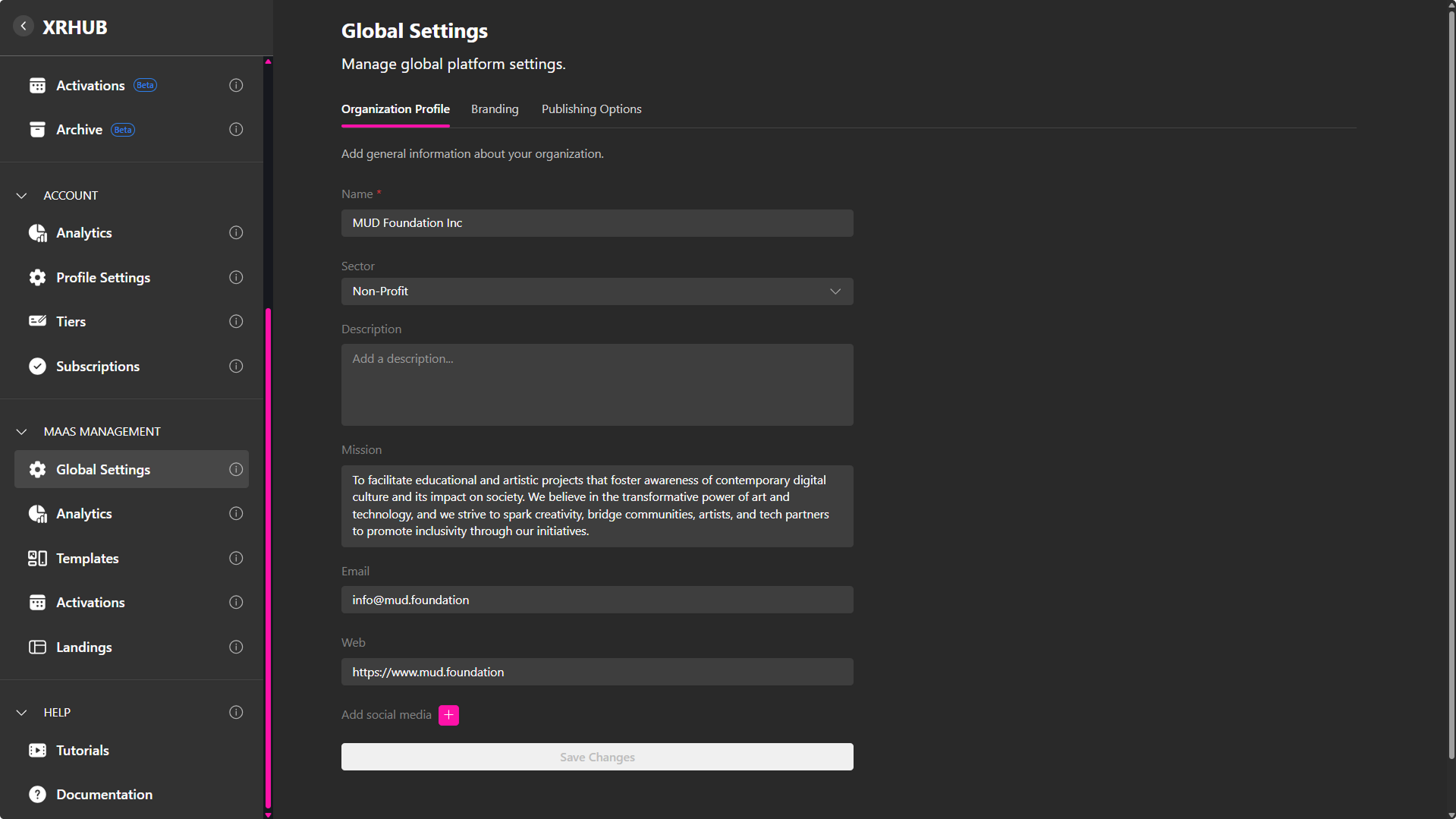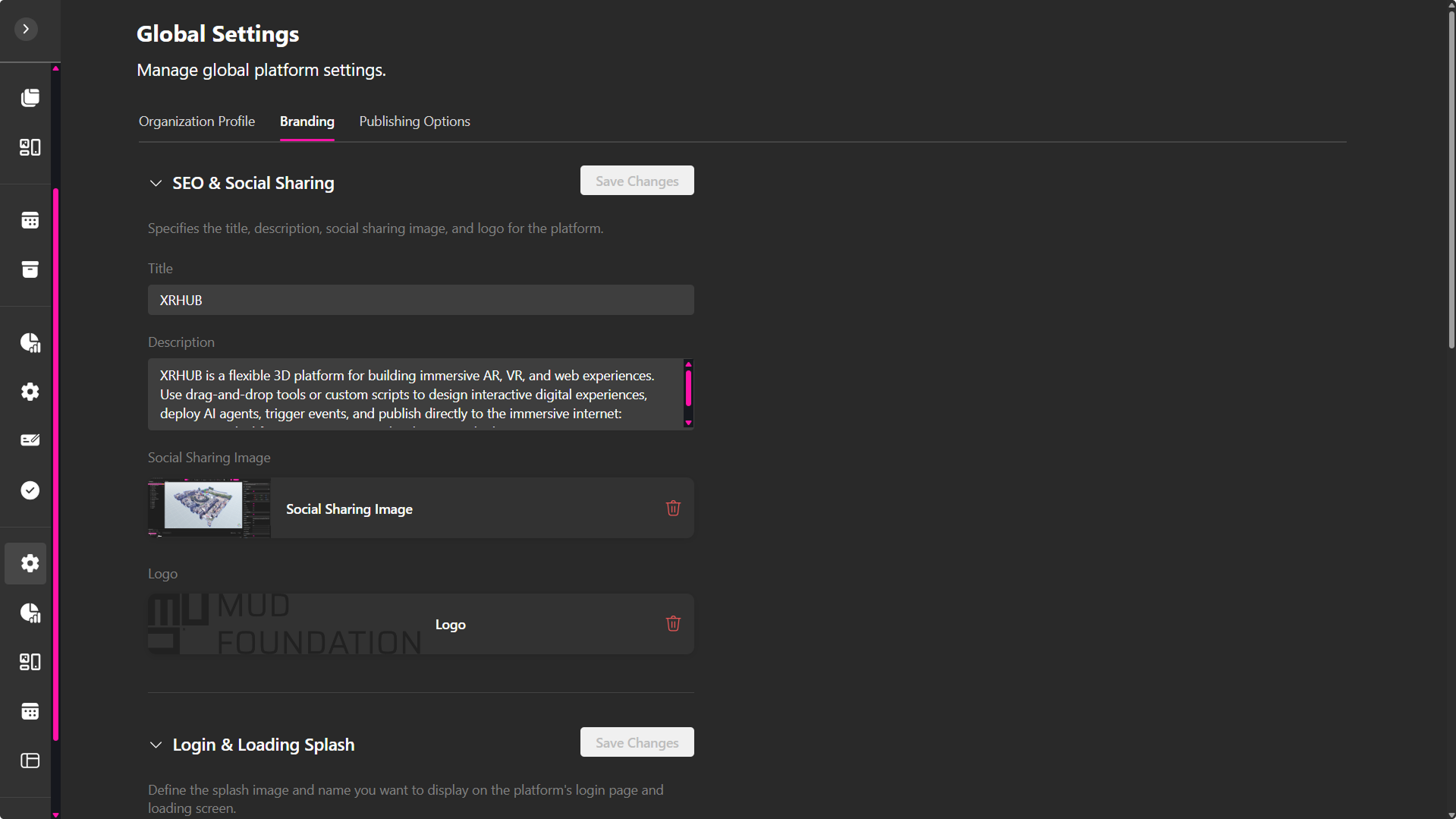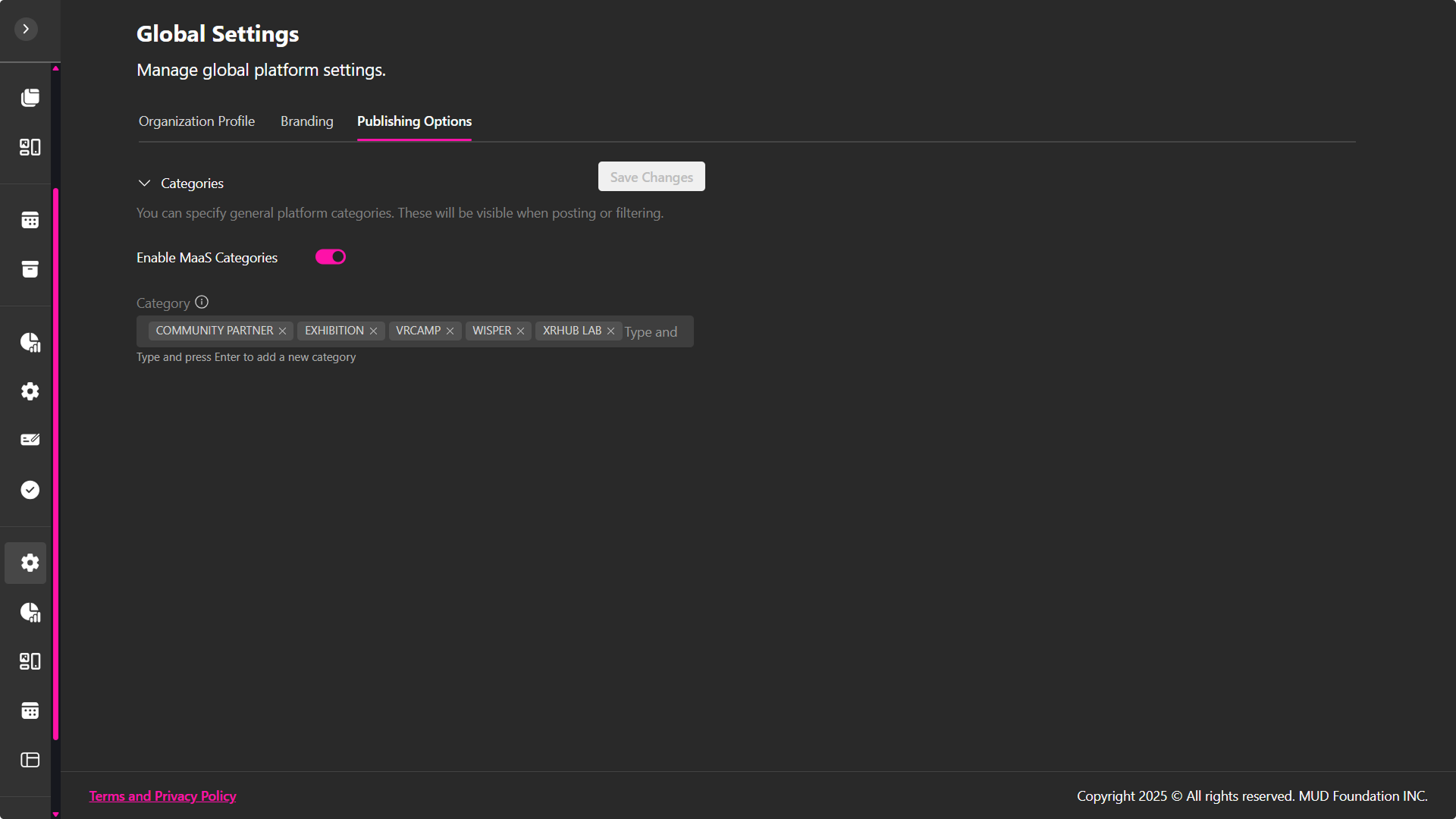Global Settings
The Global Settings panel allows administrators to configure the foundational identity, branding, and publishing parameters of their platform.
These settings define how the platform presents itself to users, how it appears publicly, and how content categories are managed.

Global Settings are divided into three main tabs:
- Organization Profile
- Branding
- Publishing Options
Organization Profile
This section manages the core identity and descriptive information of your organization as it appears across the platform.
Fields Overview
-
Name
The display name of your organization. This is shown across dropdown options for activations and verses and public-facing areas. -
Sector
The industry or category your organization belongs to. This helps contextualize the platform’s focus (e.g., Technology, Retail, Education). -
Description
A concise overview describing your platform’s purpose or offering.Example:
“The ultimate XR web metaverse platform designed to ignite creativity, foster social connections, and immerse you in a unique artistic experience.”
-
Mission
A more detailed statement describing the vision and objectives of your organization. This typically includes the background, collaborations, and long-term goals.Example:
“To facilitate educational and artistic projects that foster awareness of contemporary digital culture and its impact on society. We believe in the transformative power of art and technology, and we strive to spark creativity, bridge communities, artists, and tech partners to promote inclusivity through our initiatives.”
-
Email
The main contact email for support or inquiries. -
Web
The URL of your platform or landing page (e.g.,https://www.mud.foundation/). -
Social Media
Add links to your organization’s social platforms for integration and visibility.
Fields include:- Facebook URL
- Instagram URL
- linkedIn URL
- X (twitter) URL
- TikTok URL
Branding
The Branding tab customizes how some parts of your platform appears to users and external viewers.

It covers visual identity, SEO metadata, and loading experiences.
SEO & Social Sharing
Defines how your platform appears when shared on social media or indexed by search engines.
-
Title
The page title displayed in browsers and search results.
Example:“XRHUB”
-
Description
A brief summary for social previews or meta tags.
Example:“Mix 3D models, architecture pieces, lighting, and images to craft custom VR spaces. Whether you envision a sophisticated boardroom or a cosmic adventure, the creative power is yours!”
-
Social Sharing Image
The default image displayed when your site link is shared on social media platforms. -
Logo
Your platform’s official logo used across the interface and in shared content.
Login & Loading Splash
Customizes the appearance of the platform’s login screen and loading interface.
-
Name
The display title for the platform in the login screen (e.g., “XRHUB”). -
Splash Image
The image shown on the platform’s login and welcome screen. -
Splash Image Credits
Attribution or credits for the splash image’s creator or source.
Example:“Photography by Gustavo Perez. New Extractivism by Vladan Joler, 2022. Media Under Dys.”
-
Loading Splash Image
The image that appears during the loading process before entering the platform. -
Loading Splash Image Credits
Attribution text for the loading screen image.
Example:“Photography by Gustavo Perez. New Extractivism by Vladan Joler, 2022. Media Under Dystopia 3.0”
Themes
Controls the color scheme and overall aesthetic style of the platform’s user interface inside the metaverse.
-
Theme Configuration JSON
The theme structure is defined using JSON variables that specify color palettes and UI states.Example configuration:
"name": "MUD Default",
"id": "mud-metaverse-dark-mode",
"default": true,
"variables": {
"primary-color": "#FE12A8",
"primary-color-minor-opacity": "#FE12A81a",
"primary-color-hover": "#EA5DB6",
"primary-color-pressed": "#FE12A8",
"background2-color": "#FFFFFF",
"loading-screen-background": "#FFFFFF",
"link-color-hover": "#EA5DB6",
"link-color": "#FE12A8",
"link-color-pressed": "#FE12A8",
"accept-color-pressed": "#FE12A8",
"accent1-color": "#252525",
"accent1-color-hover": "#5D646C",
"accent1-border-color": "#2B313B",
"accent1-color-pressed": "#FFFFFF",
"accent2-color": "#252525",
"accent2-color-hover": "#5D646C",
"accent2-color-pressed": "#FFFFFF",
"accent2-border-color": "#2B313B",
"accent3-color-pressed": "#FFFFFF",
"accent3-color": "#252525",
"accent3-color-hover": "#5D646C",
"accent3-border-color": "#2B313B",
"accent4-color": "#FE12A8",
"accent4-border-color": "#FE12A8",
"accent4-color-hover": "#EA5DB6",
"accent4-color-pressed": "#FE12A8",
"accent5-color": "#252525",
"accent5-border-color": "#2B313B",
"accent5-color-hover": "#5D646C",
"accent5-color-pressed": "#FFFFFF",
"action-color": "#21242C",
"action-color-highlight": "#3d3d3d",
"border-radius-regular": "0px",
"border-radius-small": "0px",
"mic-setup-modal-bg-color": "#F5F5F5",
"toolbar-icon-selected-bg": "#E7E7E7",
"toolbar-icon-color": "#FFFFFF",
"text5-color": "#FFFFFF",
"text4-color": "#252525",
"font-family-default": "Saira, sans-serif, Poppins, -apple-system, BlinkMacSystemFont, Segoe UI, Roboto, Helvetica, Arial, sans-serif, Apple Color Emoji, Segoe UI Emoji, Segoe UI Symbol",
"navbar-background": "#000",
"navbar-text-color": "#fff"
}
Publishing Options
The Publishing Options tab manages how content categories are organized and displayed within the platform.

Categories
-
Enable MaaS Categories
Toggles the “Metaverse-as-a-Service” category system on or off. -
Category List
Define global tags or categories used for posts and filters across the platform.
Examples:
AI,Media Under Dystopia,Wisper,XR,XRCAMP,Art,ItalianThese tags help users discover content and creators more efficiently.